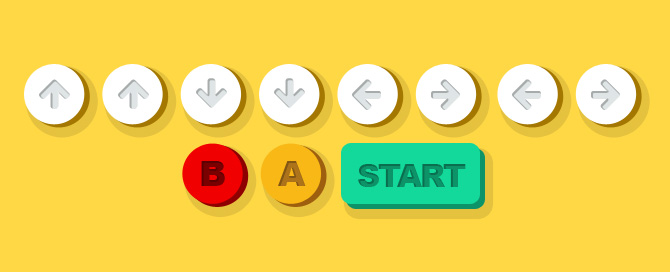Easter Eggs for Fun and Profit

By now you’re probably familiar with at least a few website Easter Eggs; after all, who hasn’t clicked on an interesting Google Doodle, or found a hidden secret by keying in the Konami code (↑↑↓↓←→←→BA) on a popular site? For those who missed Easter Egg buzz, Wikipedia defines website Easter Eggs as “secret responses that occur as a result of an undocumented set of commands. The results can vary from a simple printed message or image, to a page of programmer credits or a small video game hidden inside an otherwise serious piece of software or on the web.”
There are many blog posts that list top examples of website Easter Eggs, and you can even find a list of all known Konami code websites at konamicodesites.com. We decided to take a slightly different angle and see how putting a little time and thought into an easter egg can serve as a fun and effective marketing tool, driving extra traffic to your website and making your brand just that much more memorable than those of less savvy competitors. Here are five design tips for adding easter eggs to your company’s website.
- Make sure it makes sense: Konami code easter eggs make a lot of sense for game-related websites, but if your customer base doesn’t include people who grew up on NES and Playstation, you might put a lot of effort into implementing a sweet easter egg only to find that no one ever sees it. Think about your brand, and the kinds of surprise features that would reinforce your core areas of competency. Consider your customers, too – the ones you have and those you want to find. What would they find entertaining and funny?
- Keep it simple… but not too simple: Hide and seek is no fun when things are hidden in plain sight, but it also loses its charm when you exhaust yourself and find nothing at all. Which parts of your web application see the most traffic? Is there an I/O feature already in place, like a search bar or a comment field, that you could use to house your surprise? Your easter egg should be simple enough that someone could, conceivably, find it by accident, lest you find yourself needing to deliberately leak information about your hidden feature.
- Don’t sacrifice customer security for your Easter Egg: This sounds obvious, but particularly if your easter egg is accessible to paying customers after logging in, you need to make sure the code is clean enough to not create an unexpected security flaw. Check out our security tips for your web application to make sure that you are not putting your customers’ security at risk.
- Make it fun: Easter eggs are pretty much limitless in potential in terms of type, content, and message: You can include a little game, play a brief video, or even just include simple ASCII art in your website’s source code. Keep in mind, however, that in order for your easter egg to serve as an effective marketing tool, it will have to be memorable and, 9 times out of 10, positive. Remember, the idea is for this to generate publicity, so make sure you would be willing to speak publicly about the content you include!
- Test thoroughly: Putting in the effort to design and implement an easter egg only to have it fail is almost more sad than a buggy website. Make sure you test your easter egg thoroughly, across a variety of browsers, with different screen sizes and resolutions, using different input methods (touch screen versus keyboard, etc.) so that your easter egg will reach the widest possible audience.
Ready to add a little fun to your own web application? Contact us to get started!